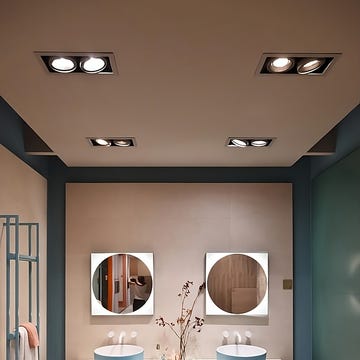From more eco-friendly building materials to renewable energy sources, creating a property that is kinder to the planet is high on many homeowners' wish lists – and may even save you some money in the long-run.
A greater focus on sustainable innovation within the world of interiors is allowing increasing numbers of us to create functional and stylish living spaces that are also more eco-friendly. However significant the changes you're looking to make to your own home, here are five things to consider before work gets underway.
1. Choose building materials wisely
Large-scale renovations can be incredibly energy-intensive, but there are ways to reduce this. The key to creating a more sustainable home is making use of resources with minimal environmental impact, such as sustainably sourced timber, reclaimed wood and cellulose insulation. Quartz, for example, is more eco-friendly because it features a longer replacement life (meaning that it's hard-wearing and needs updating less frequently – ideal for worktops). Meanwhile, bamboo is a natural composite material with a high strength-to-weight ratio that's useful for structures.
What's everyone reading?
If you’re planning a big project that requires contractors and building work, speak to your design team about creating a space that’s kind to the planet. Don't be afraid to ask questions about where materials come from or how they are made.
2. Consider sustainable ceramics
Naturally abundant ceramics and clay products are generally more sustainable wherever they're sourced, but Italian-made ceramics raise the bar even further. Made using post-consumer recycled materials, 99.5% of production and purification waste is reused in their production cycle, while 44% of the energy required for production comes from renewable sources or cogeneration.
From high-tech porcelain slabs to sanitaryware, Ceramics of Italy represents more than 150 manufacturers of the finest ceramics, all of which have been chosen for their craftsmanship, quality, innovation and sustainability – ideal for inspiring for your bathroom makeover, finding statement tiles for your kitchen splashback or updating your tableware collection.
3. Use low-toxicity paints
Colour plays a crucial role in creating a space that inspires and feels personal to you, but how sustainable is your paint? Whichever room you’re redecorating, eco-friendly paints are an excellent solution thanks to their lower VOC content.
However, when you’re looking for a good eco-paint, always check the label. Some brands contain seemingly great things like natural oils, but then require chemicals such as white spirit to wash them off the paintbrush, rather than water, adding more solvents back into the process. You can also donate or recycle any leftover paint to designated sites – Recycle Now has a useful tool to find your nearest drop-off point.
4. Shop second-hand
On the hunt for a statement vase? Looking to invest in a rustic dining table? Shopping vintage or refurbished finds is not only an excellent way to breathe new life into your interiors, but it often means you can source one-of-a-kind pieces to make your home stand out.
If you prefer to buy new for certain items, another option is to shop smaller, from artisan producers who use sustainable materials. Many of the manufacturers represented by Ceramics of Italy offer products that are hand-crafted by locals; a more personal alternative to mass-produced products. All producers awarded the Ceramics of Italy label are recognised for the high quality of their production while respecting the environment and workers.
5. Look into renewable energy
With energy bills continuing to skyrocket, many of us are considering more sustainable ways of powering our homes. Choosing renewable energy sources for your electricity and heating is a good way to lessen your carbon footprint, while also helping to reduce some forms of air pollution.
If finances allow, consider installing solar panels on your roof to generate power during daylight hours. Alternatively, an air source heat pump, often known as an air-to-water source heat pump, cleverly transfers heat from the outside air to water, heating your room via radiators.
Find out more about Ceramics of Italy at ceramica.info














